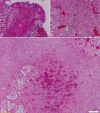Giant Inflammatory Fibroid Polyp of the Descending Colon Treated with Endoscopic Resection
- PMID: 26157816
- PMCID: PMC4435274
- DOI: 10.14309/crj.2013.14
Giant Inflammatory Fibroid Polyp of the Descending Colon Treated with Endoscopic Resection
Abstract
Inflammatory fibroid polyps (IFPs) of the colon are very rare, reactive, non-neoplastic polyps that may grow to large sizes but do not carry any risk of malignancy. Because of their size, IFPs are usually treated with surgery; however, size alone should not be an indication for surgery. Depending on the location and morphology of the polyp, endoscopic resection should be considered. We here describe a case of a giant IFP that was successfully removed with endoscopy without complication or recurrence.
Figures



Similar articles
-
Giant Inflammatory Fibroid Polyp of the Hepatic Flexure of Colon Presenting with an Acute Abdomen.Case Rep Gastrointest Med. 2016;2016:2178639. doi: 10.1155/2016/2178639. Epub 2016 Oct 3. Case Rep Gastrointest Med. 2016. PMID: 27781129 Free PMC article.
-
Unusual presentation of a giant benign inflammatory polyp in the upper esophagus.Int J Surg Case Rep. 2015;6C:206-9. doi: 10.1016/j.ijscr.2014.12.013. Epub 2014 Dec 19. Int J Surg Case Rep. 2015. PMID: 25544491 Free PMC article.
-
Gastric inflammatory fibroid polyp tumor with acute intestinal obstruction-Vanek's tumor can mimick a giant gastrointestinal stromal tumor or a gastric lymphoma.J Vis Surg. 2018 Mar 16;4:54. doi: 10.21037/jovs.2018.02.09. eCollection 2018. J Vis Surg. 2018. PMID: 29682464 Free PMC article.
-
Experience in the endoscopic management of large colonic polyps.ANZ J Surg. 2003 Dec;73(12):988-95. doi: 10.1046/j.1445-2197.2003.t01-23-.x. ANZ J Surg. 2003. PMID: 14632888 Review.
-
Invasive inflammatory fibroid polyp of the stomach: a case report and literature review.BMC Gastroenterol. 2018 May 31;18(1):74. doi: 10.1186/s12876-018-0808-9. BMC Gastroenterol. 2018. PMID: 29855265 Free PMC article. Review.
Cited by
-
Giant Inflammatory Fibroid Polyp of the Hepatic Flexure of Colon Presenting with an Acute Abdomen.Case Rep Gastrointest Med. 2016;2016:2178639. doi: 10.1155/2016/2178639. Epub 2016 Oct 3. Case Rep Gastrointest Med. 2016. PMID: 27781129 Free PMC article.
-
Inflammatory Fibroid Polyp of the Gastrointestinal Tract: A Systematic Review for a Benign Tumor.In Vivo. 2021 Jan-Feb;35(1):81-93. doi: 10.21873/invivo.12235. In Vivo. 2021. PMID: 33402453 Free PMC article.
-
Masquerading in the midgut: a rare diagnosis in a patient with recurrent abdominal pain.Frontline Gastroenterol. 2019 Jun 27;11(5):420-422. doi: 10.1136/flgastro-2019-101222. eCollection 2020. Frontline Gastroenterol. 2019. PMID: 32879725 Free PMC article.
-
Two Cases of Leiomyoma in the Colon Masquerading as Other Types of Colonic Pedunculated Polyps.Case Rep Gastrointest Med. 2018 Apr 29;2018:8272313. doi: 10.1155/2018/8272313. eCollection 2018. Case Rep Gastrointest Med. 2018. PMID: 29854494 Free PMC article.
-
Giant Ileocecal Inflammatory Fibroid Polyp: Unique Clinical Presentation.Case Rep Surg. 2020 Jul 21;2020:8811404. doi: 10.1155/2020/8811404. eCollection 2020. Case Rep Surg. 2020. PMID: 32774977 Free PMC article.
References
-
- Matsushita M, Hajiro K, Okazaki K, Takakuwa H. Gastric inflammatory fibroid polyps: Endoscopic ultrasonographic analysis in comparison with the histology. Gastrointest Endosc. 1997;46(1):53–7. - PubMed
-
- Sakamoto T, Kato H, Okabe T, et al. . A large inflammatory fibroid polyp of the colon treated by endoclip-assisted endoscopic polypectomy. Dig Liver Dis. 2005;37(12):968–72. - PubMed
-
- Konjetzny GE. Uber magenfibrome. Beitr Klin Chir. 1920;119:53–61.
-
- Kofler E. Uber die granulome des magen-darmashlauches. Virchows Arch. 1952;321(2):121–33. - PubMed
-
- Helwig EB, Ranier A. Inflammatory fibroid polyps of the stomach. Surg Gynecol Obstet. 1953;96(3):335–67. - PubMed
Publication types
LinkOut - more resources
Full Text Sources
Other Literature Sources

